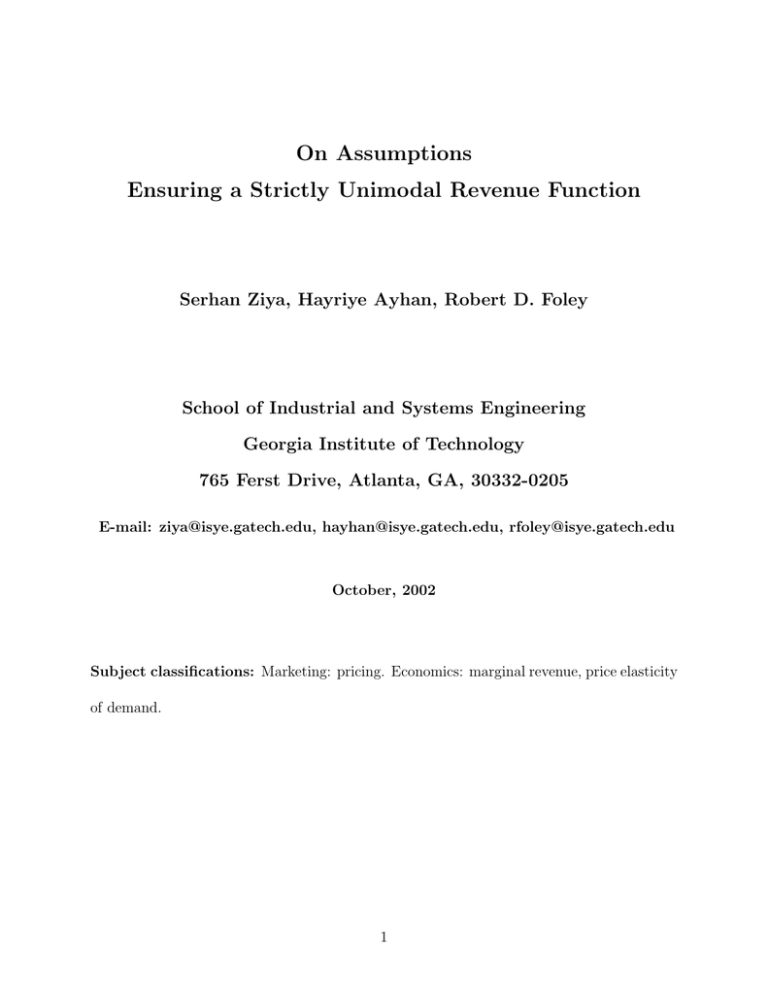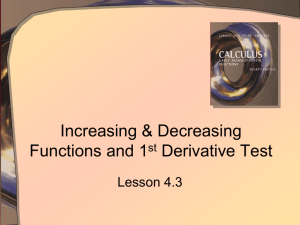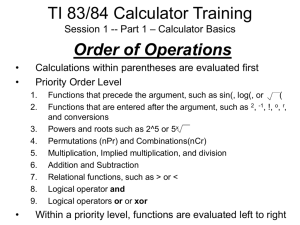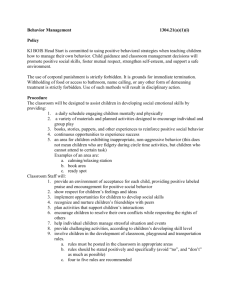On Assumptions Ensuring a Strictly Unimodal Revenue Function
advertisement

On Assumptions
Ensuring a Strictly Unimodal Revenue Function
Serhan Ziya, Hayriye Ayhan, Robert D. Foley
School of Industrial and Systems Engineering
Georgia Institute of Technology
765 Ferst Drive, Atlanta, GA, 30332-0205
E-mail: ziya@isye.gatech.edu, hayhan@isye.gatech.edu, rfoley@isye.gatech.edu
October, 2002
Subject classifications: Marketing: pricing. Economics: marginal revenue, price elasticity
of demand.
1
Abstract
This note discusses the relationships among three assumptions which appear frequently in the pricing literature. Each of these assumptions ensures that a “revenue
function” is strictly unimodal over the region of interest. The three assumptions are
decreasing marginal revenue with respect to demand, decreasing marginal revenue with
respect to price and decreasing price elasticity of demand. We provide proofs and examples to show that none of these conditions is more restrictive than any other, but
they can be ordered from strongest to weakest when restricted to certain parameter
regions.
2
1
Introduction
In this note, our aim is to discuss the relationships among three assumptions which are
prevalent in the pricing/yield management literature. Our and many other researchers’ motivation comes from a pricing problem where the mathematical relationship between price
and demand is known, and revenue can be defined as a function of either price or demand.
The assumptions we investigate in this note ensure that this “revenue function” is strictly
unimodal over the region of interest. These assumptions also have economic interpretations
so that their relationships are of interest even without the fact that they ensure strict unimodality. Strict unimodality is important since it implies a unique local maximum, which
is at the same time the unique global maximum (see Appendix for a definition of strict
unimodality). In the following sections, we first define the model and state the assumptions,
then show that these assumptions imply each other over restricted regions of price and demand. Finally, we provide counterexamples demonstrating that none of these assumptions
is more restrictive than any other.
2
Model Description
We consider a fairly standard price – demand formulation which assumes that the mathematical relation between price and demand is known. We use x to denote the price (of a
product, service etc.) and y to denote the demand (demand in a time period, demand per
time etc.). We use d(x) to denote the demand corresponding to price x and we assume that
it is bounded. Hence, y = d(x) ≤ D for all x for some D < ∞.
Assuming that there exists a unique price corresponding to each demand value, we define
3
the function p(·) as the inverse demand function. Given the demand value, p(·) returns the
corresponding price. Thus, x = p(y). Then, one has the flexibility of defining what we call
the “revenue function” either as a function of price or as a function of demand. We use Rp (·)
to denote the revenue function defined in terms of the price which can be written as:
Rp (x) = xd(x) for x ∈ [0, ∞).
(1)
Similarly, we use Rd (·) to denote the revenue function defined in terms of the demand:
Rd (y) = yp(y) for y ∈ [0, D]
(2)
where 0 < D < ∞ is the least upper bound on the demand (D = inf{τ : τ ≥ d(x)∀x}).
Obviously, we have Rp (x) = Rd (y) for y = d(x) (or x = p(y)).
Since the function d(·) is bounded, it can be rewritten as:
d(x) = D(1 − F (x)) for x ∈ [0, ∞)
(3)
where 0 ≤ F (x) ≤ 1 for x ≥ 0. One way to interpret D and the function F (·) is as follows.
The parameter D is the potential number of customers (or the potential arrival rate of
customers), that is the demand the manager faces when the price is set to zero. If the price
is set to x, each potential customer decides to buy the product (or join the system) with a
probability of 1 − F (x). Then, d(x) is the expected demand or the demand rate given price
x.
In the literature, there is a variety of work where the revenue function in the form of
(1) or (2) comes up. Different authors make different assumptions on these functions to
have analytically tractable models. The purpose of this note is to explore the relationships
4
among three of these assumptions each of which ensures that the revenue function is strictly
unimodal over the interval where it is strictly positive. These assumptions are:
A1 Rd (y) is strictly concave for y ∈ (0, D).
A2 Rp (x) is strictly concave for x ∈ (xmin , xmax ) where xmin = sup{x : d(x) = D} is the
greatest price for which the demand is D and xmax = inf{x : d(p) = 0} is the smallest
price for which the demand is zero.
A3 e(x) = xh(x) is strictly increasing for x ∈ (xmin , xmax ) where h(x) = f (x)/(1 − F (x))
is the hazard rate function for the distribution function F (·) and f (·) is the p.d.f. for
F (·).
These assumptions also have some economic implications. Assumption A1 implies that
marginal revenue with respect to demand is decreasing whereas assumption A2 implies
marginal revenue with respect to price is decreasing. It can be shown that −e(·) is the
price elasticity of demand function (see Ziya, Ayhan and Foley 2002). Thus, assuming A3
is equivalent to assuming that price elasticity is decreasing. The fact that A3 ensures strict
unimodality can be shown by taking the derivative of (1) with respect to x. (This is also
an immediate consequence of a well known result from the economics literature that defines
marginal revenue as a function of price elasticity. For example, see Ryan 1958.)
To our knowledge, A1 is the most widely used of these three assumptions. For example,
see Feichtinger and Hartl (1985), Li (1988), Gallego and van Ryzin (1994), Paschalidis and
Tsitsiklis (2000) and Chatwin (2000) (with a finite set of prices). Bitran and Mondschein
(1997) assume that the function (1−Ft (x))2 /ft (x) (where subscript t is for time) is decreasing
5
in x but it can be shown that this assumption is equivalent to A1 if ft (x) is differentiable
in x. In general, it seems that researchers find it more convenient to make the demand
decision variable (rather than the price) and therefore assuming concavity in price (A2)
is not common. For an example, see Yoshida (2002). On the other hand, Lariviere and
Porteus (2001), Fridgeirsdottir and Chiu (2001) and Ziya, Ayhan and Foley (2002) assume
A3. In the paper by Lariviere and Porteus, D and F (·) have completely different meanings.
However, the form of their revenue function is exactly the same as (1) with the function d(·)
defined as in (3) (although it is not a demand function) and therefore their assumption is
technically the same as A3. Fridgeirsdottir and Chiu (2001) also consider the assumption
that the function h(x) is strictly increasing. This assumption obviously implies A3 but the
authors show that it also implies A1. Hempenius (1970) considers a profit function which
involves a cost term and gives sufficient conditions which ensure that the solution to the first
order condition is the optimal solution. Hempenius shows that in addition to the convexity
assumption for the cost, it is sufficient to assume either A3 or another condition which is
equivalent to A1. Finally, we should point out that there is also work that directly assumes
that Rp (·) is unimodal (e.g. see Polatoglu 1991).
The problem we are interested in is whether any of these three assumptions are weaker
or stronger than the other(s). Lariviere and Porteus (2001) argue that their concavity
assumption does not hold for most common distributions such as the Normal distribution.
(Note that their concavity assumption corresponds to concavity in price according to our
definition.) In the following sections, we will show that none of these assumptions is more
restrictive than any other. However, we will prove some implications among the assumptions
over restricted regions of price and demand.
6
Before giving our results, we shall complete our model description. We assume that
d(x) = D (or F (x) = 0) for x ≤ xmin which implies that Rp (x) is strictly increasing for
x < xmin . One can also see that Rp (x) = 0 for x ≥ xmax . We also assume that the function
F (x) is strictly increasing and twice differentiable over (xmin , xmax ) so that f (x) > 0 for
x ∈ (xmin , xmax ). Since F (·) is strictly increasing, from (3) it immediately follows that
demand function d(x) is strictly decreasing over (xmin , xmax ). Then, there is a unique price
corresponding to any y ∈ (0, D) and the function d(x) has an inverse for x ∈ (xmin , xmax ).
Without loss of generality, we define p(0) = xmax and p(D) = xmin . Then, using (3) we can
define function p(·) as
p(y) = F −1 (1 − y/D) for y ∈ [0, D],
(4)
where F −1 (·) is the inverse of F (·).
3
Equivalent Conditions
Assumptions A1, A2 and A3 are difficult to compare since they are quite different on the
surface. In this section, we give three conditions C1, C2 and C3 that are equivalent to A1,
A2 and A3, respectively. The advantage of C1, C2 and C3 is that they are all expressed in
terms of the function F (·) and its derivatives.
These conditions are:
C1 2(f (x))2 + (1 − F (x))f 0 (x) > 0 for x ∈ (xmin , xmax ).
C2 2f (x) + xf 0 (x) > 0 for x ∈ (xmin , xmax ).
C3 (f (x) + xf 0 (x))(1 − F (x)) + x(f (x))2 > 0 for x ∈ (xmin , xmax ).
7
Then, we have the following result:
Proposition 3.1 Assumptions A1, A2 and A3 are equivalent to the conditions C1, C2 and
C3, respectively.
The proof follows immediately from Lemma A.1 which is given in the Appendix.
4
Implications Over Restricted Regions
Even though we will show that none of the assumptions A1, A2 and A3 are more restrictive
than the other two, there are some implications among the assumptions over restricted
regions of price and demand. We first define these parameter regions.
Let x∗ be the optimal price that maximizes (1). Under any of the three assumptions, it
can be shown that (see Ziya, Ayhan and Foley 2002)
x∗ = inf{x : e(x) ≥ 1}.
(5)
Hence, Rp (x) is increasing for any x < x∗ and decreasing for xmax > x > x∗ . Let the sets
Ap and Ad be defined as Ap = {x : x ∈ (xmin , x∗ ]}, Ad = {y : p(y) ∈ (xmin , x∗ ]}. Then,
Ap is the set of prices for which Rp (x) is non-decreasing and Ad is the set of demand values
corresponding to the prices for which Rp (x) is non-decreasing. Note that Ad can also be
described as the set of demand values for which Rd (y) is non-increasing. Also, let Acp and
Acd denote the complementary sets with respect to the intervals (xmin , xmax ) and (0, D),
respectively. Then, in the Appendix, we prove the following result:
8
Proposition 4.1
(i) If Rd (y) is strictly concave for y ∈ Ad , then e(x) is strictly increasing for x ∈ Ap .
(ii) If e(x) is strictly increasing for x ∈ Ap , then Rp (x) is strictly concave for x ∈ Ap .
(iii) If Rp (x) is strictly concave for x ∈ Acp , then e(x) is strictly increasing for x ∈ Acp .
(iv) If e(x) is strictly increasing for x ∈ Acp , then Rd (y) is strictly concave for y ∈ Acd .
Note that the fact that A3 implies A2 over the parameter region Ap has already been shown
by Lariviere and Porteus (2001).
Proposition 4.1 is not sufficient to claim that any of these three assumptions is stronger
or weaker than the others. In fact, the nature of their relationships suggests that they are
different conditions. We provide some examples showing that this is indeed the case.
5
Counterexamples
In this section, we give three examples to show that none of the assumptions A1, A2 and A3
is more restrictive than any other. Each example satisfies only one of A1, A2 and A3. The
examples also disprove the converse of the statements given in Proposition 4.1.
The following example satisfies A1, but neither A2 nor A3. Furthermore, this example
shows that the converse of Proposition 4.1 (iv) does not hold.
Example 1: Suppose that F (x) = 1 − (x − ε)−2 where x ∈ [1 + ε, ∞) and 0 < ε < ∞.
Then, we have
2(f (x))2 + (1 − F (x))f 0 (x) =
9
2
>0
(x − ε)6
for x ≥ 1 + ε. Thus, A1 holds. However,
2f (x) + xf 0 (x) = 2(x − ε)−4 (−x − 2ε) < 0
for x ≥ 1 + ε which implies that A2 does not hold (in fact Rp (x) is convex for x ≥ 1 + ε).
Finally, we have
e(x) =
2x
x−ε
which is a decreasing function for x ≥ 1 + ε. Therefore, A3 does not hold. Also, since
x∗ = 1 + ε, we conclude that the converse of Proposition 4.1 does not hold.
The following example satisfies A2, but neither A1 nor A3. It also shows that the converse
of Proposition 4.1 (ii) does not hold.
Example 2: Suppose that
0.2x − x3 /3
for 0 ≤ x ≤ 0.3
F (x) =
4x3 /3 − 3x2 /2 + 0.65x − 0.045 for 0.3 < x ≤ 1.241049
.
Note that xmax ≈ 1.241049. Then, we have
2f (x) + xf 0 (x) =
0.4 − 4x2
for 0 ≤ x ≤ 0.3
16x2 − 9x + 1.3 for 0.3 < x ≤ 1.241049
.
It can be shown that 2f (x) + xf 0 (x) > 0 for 0 ≤ x ≤ 1.241049. Thus, A2 holds. We have
2(f (x))2 + (1 − F (x))f 0 (x) = 0.08 − 2x − 0.4x2 + 4x4 /3 for 0 ≤ x ≤ 0.3.
Then, for x = 0.1, 2(f (x))2 + (1 − F (x))f 0 (x) is approximately −0.123867. Therefore, A1
does not hold. Finally, we have
(f (x) + xf 0 (x))(1 − F (x)) + x(f (x))2 = 0.2 + 4/15x3 − 3x2 for 0 ≤ x ≤ 0.3.
10
Then, for x = 0.29, (f (x) + xf 0 (x))(1 − F (x)) + x(f (x))2 is approximately −0.045796. Thus,
A3 does not hold. Since it can also be shown that x∗ > 0.3, we conclude that the converse
of Proposition 4.1(ii) does not hold.
Our last example below satisfies A3, but neither A1 nor A2. It also shows that the
converses of Proposition 4.1 (i) and (iii) do not hold. Note that an example that satisfies A3
but not A2 has also been given in Hempenius (1970).
Example 3: Let 0 < α < 1 and β > 0 and suppose that F ∼ W eibull(α, β). Then, it
can be shown that e(x) = α(x/β)α . Obviously e(x) is increasing so that A3 holds. We have
α
2(f (x))2 + (1 − F (x))f 0 (x) = αβ −α xα−2 e2(−(x/β) ) (αβ −α xα + α − 1).
Then, 2(f (x))2 + (1 − F (x))f 0 (x) < 0 for x ∈ (0, β((1 − α)/α)1/α ). Hence, A1 does not hold.
It also implies that the converse of Proposition 4.1 (i) does not hold. Moreover, we have
α
2f (x) + xf 0 (x) = αβ −α xα−1 e−(x/β) (1 + α − α(x/β)α ).
Then, 2f (x) + xf 0 (x) < 0 for x ∈ [β((1 + α)/α)1/α , ∞). This implies that A2 does not hold.
Since x∗ = β(α)(−1/α) , we also conclude that the converse of Proposition 4.1 (iii) does not
hold. (Note that for α ≥ 1, it can be shown that A1 holds.)
6
Conclusions
We showed that none of the assumptions A1, A2 and A3 can be claimed to be more restrictive
than any other. However, when restricted to certain parameter regions, we showed that
the assumptions can be ordered from the strongest to the weakest. In fact if one is only
11
interested in having a strictly unimodal revenue function, assumptions A1, A2 and A3 are
more restrictive than necessary. Less restrictive assumptions would be
• Rd (y) is strictly concave for y ∈ Acd .
• Rp (x) is strictly concave for x ∈ Acp .
• e(x) is strictly increasing for x ∈ Acp .
In this case, from Proposition 4.1 and examples 1 and 3 above, we know that concavity in
price is more restrictive than assuming a decreasing price elasticity function, which is more
restrictive than assuming concavity in demand.
Our results also have some economic implications. Since e(x) ≤ 1 for x ∈ Ap and
e(p(y)) ≤ 1 for y ∈ Ad , Ap and Ad are respectively the set of prices and set of demand
values for which the demand is inelastic (or unit elastic for x∗ ). Similarly, Acp and Acd are
respectively the set of prices and set of demand values for which the demand is elastic. Then,
from Proposition 4.1, we know that over the region where demand is inelastic, decreasing
marginal revenue with respect to demand implies decreasing price elasticity, which in turn
implies decreasing marginal revenue with respect to price. On the other hand, over the
region where demand is elastic, decreasing marginal revenue with respect to price implies
decreasing price elasticity, which in turn implies decreasing marginal revenue with respect
to demand. Finally, from the examples, we also know that none of these implications are
correct in the opposite direction.
12
A
Appendix
The following definition, originally given in Bertsekas (1999) for a minimization problem is
rephrased for a maximization problem.
Definition A.1 A function g : [0, s] → R is said to be strictly unimodal if it has a unique
global maximum α∗ in [0, s], and if α1 , α2 are two points in [0, s] such that α1 < α2 < α∗ or
α∗ < α1 < α2 , then g(α1 ) < g(α2 ) < g(α∗ ) or g(α∗ ) > g(α1 ) > g(α2 ), respectively.
In the proofs of Lemma A.1 and Proposition 4.1 given below, we frequently use the model
assumptions given in the paragraph that contains (4).
Lemma A.1 Let a ∈ R and b ∈ R be such that xmin ≤ a < b < xmax . Then,
(i) Rd (y) is strictly concave for y ∈ [d(b), d(a)] if and only if 2(f (x))2 + (1 − F (x))f 0 (x) > 0
for x ∈ (a, b).
(ii) Rp (x) is strictly concave for x ∈ [a, b] if and only if 2f (x) + xf 0 (x) > 0 for x ∈ (a, b).
(iii) e(x) is strictly increasing for x ∈ [a, b] if and only if (f (x) + xf 0 (x))(1 − F (x)) +
x(f (x))2 > 0 for x ∈ (a, b).
Proof Part (ii) immediately follows after taking the second derivative of Rp (x) with respect
to x and part (iii) follows after taking the first derivative of e(x).
For part (i), first let F −1 (·) = G(·). Then G(z) is differentiable for 0 < z < 1 since F (·)
is differentiable and f (G(z)) > 0 for 0 < z < 1 (e.g. see Edwards and Penney 1990). Let
G0 (·) be the first derivative of G(·). Using F (G(z)) = z, we get f (G(z))G0 (z) = 1 and it
13
follows that
1
for 0 < z < 1.
f (G(z))
G0 (z) =
(6)
Then, using (6), the fact that G(z) is differentiable for 0 < z < 1 and chain rule (e.g. see
Edwards and Penney 1990) we conclude that G0 (z) is differentiable for 0 < z < 1. Let G00 (z)
denote the second derivative of G(·). Then, using (6), we get
G00 (z) = −
f 0 (G(z))
for 0 < z < 1.
(f (G(z)))3
(7)
Now, twice differentiating Rd (y) with respect to y, using (6) and (7), for 0 < y < D, we get
the following:
d2 (Rd (y))
dy 2
= 2 dp(y)
+ yd
dy
2 (p(y))
dy 2
= − y2 G0 (1 − y/D) +
=
1
−2
(
D f (G(1−y/D))
−
y
G00 (1
D2
− y/D)
y f 0 (G(1−y/D))
).
D (f (G(1−y/D)))3
Let x = G(1 − y/D). Then, y/D = 1 − F (x) and we have
d2 (Rd (y))
dy 2
(1−F (x))f 0 (x)
)
(f (x))3
=
1
2
(− f (x)
D
=
1 −2(f (x))2 −(1−F (x))f 0 (x)
(
).
D
(f (x))3
−
Hence, the result follows using the fact that f (x) > 0 since F (x) is a strictly increasing
function.
2
Proof of Proposition 4.1:
(i) Let y ∈ Ad and x = p(y). Then,
(f (x) + xf 0 (x))(1 − F (x)) + x(f (x))2 =
f (x)(1 − F (x)) + xf 0 (x)(1 − F (x)) + x(f (x))2
>
f (x)(1 − F (x)) − 2x(f (x))2 + x(f (x))2
=
f (x)((1 − F (x)) − x(f (x)))
≥0
14
where the strict inequality follows from Lemma A.1 (i) and the last inequality follows from
the fact that x ∈ Ap . Thus, the result follows from Lemma A.1 (iii).
(ii) Let x ∈ Ap . From Lemma A.1 (iii), we have
(f (x) + xf 0 (x))(1 − F (x)) + x(f (x))2 > 0.
Since x ∈ Ap , we have xf (x) ≤ 1−F (x) from which it follows that x(f (x))2 ≤ f (x)(1−F (x)).
Then, we have
2f (x)(1 − F (x)) + xf 0 (x)(1 − F (x)) = (1 − F (x))(2f (x) + xf 0 (x)) > 0
which implies that 2f (x) + xf 0 (x) > 0 since 1 − F (x) > 0 for x ∈ Ap . Hence, the result
follows from Lemma A.1 (ii).
(iii) Let x ∈ Acp . Then,
(f (x) + xf 0 (x))(1 − F (x)) + x(f (x))2 = f (x)(1 − F (x)) + xf 0 (x)(1 − F (x)) + x(f (x))2
> f (x)(1 − F (x)) − 2(f (x))(1 − F (x)) + x(f (x))2
= f (x)(x(f (x) − (1 − F (x))))
> 0
where the first inequality follows from Lemma A.1 (ii) and the second inequality follows from
the fact that x ∈ Acp . Then, the result follows from Lemma A.1 (iii).
(iv) Let x ∈ Acp . Using Lemma A.1(iii), it can be shown that
−
f (x)(1 − F (x))
< (f 0 (x)(1 − F (x)) + (f (x))2 ).
x
15
Then, we have
2(f (x))2 + (1 − F (x))f 0 (x) =
(f (x))2 + ((f (x))2 + (1 − F (x))f 0 (x))
f (x)(1−F (x))
x
>
(f (x))2 −
=
f (x)(f (x) −
1−F (x)
)
x
>0
where the last inequality follows from the fact that x ∈ Acp . Then, the result follows from
Lemma A.1 (i).
2
Acknowledgement:
We would like to thank Prof. Faiz A. Al-Khayyal for his comments on a previous draft of
this technical note.
References
Bertsekas D. P. 1999. Nonlinear Programming. Athena Scientific, Belmont, MA, 726.
Bitran, G. R. and S. V. Mondschein. 1997. Periodic Pricing of Seasonal Products in
Retailing. Management Science. 43, 64-79.
Chatwin, R. E. 2000. Optimal Dynamic Pricing of Perishable Products with Stochastic
Demand and a Finite Set of Prices. European Journal of Operational Research. 125,
149-174.
Edwards C. H., Jr. and D. E. Penney. 1990. Calculus and Analytic Geometry. Prentice-Hall
International, Inc., Englewood Cliffs, NJ, 93, 103.
16
Feichtinger, G. and R. Hartl. 1985. Optimal Pricing and Production in an Inventory Model.
European Journal of Operational Research. 19, 45-56.
Fridgeirsdottir, K. and S. Chiu. 2001. Pricing and Marketing Decisions in Delay Sensitive Markets. Working Paper. Department of Management Science and Engineering,
Stanford University, Stanford, CA.
Gallego, G. and G. van Ryzin. 1994. Optimal Dynamic Pricing of Inventories with Stochastic Demand over Finite Horizons. Management Science. 40, 999-1020.
Hempenius, A. L. 1970. Monopoly with Random Demand. Rotterdam University Press,
The Netherlands, 74-76.
Lariviere, M. A. and E. L. Porteus. 2001. Selling to the Newsvendor: An Analysis of PriceOnly Contracts. Journal of Manufacturing and Service Operations Management. 3,
293-305.
Li, L. 1988. A Stochastic Theory of the Firm. Mathematics of Operations Research. 13,
447-466.
Paschalidis, I. Ch. and J. N. Tsitsiklis. 2000. Congestion-Dependent Pricing of Network
Services. IEEE/ACM Transactions on Networking. 8, 171-184.
Polatoglu, L. H. 1991. Optimal Order Quantity and Pricing Decisions in Single-Period
Inventory Systems. International Journal of Production Economics. 23, 175-185.
Ryan, W. J. L. 1958. Price Theory. Macmillan & Co Ltd, London, Great Britain, 283.
17
Yoshida, Y. 2002. Bertrand-Edgeworth Price Competition with Strictly Convex Cost Functions. Working Paper. Faculty of Economics, Seikei University, Japan.
Ziya, S., H. Ayhan and R. D. Foley. 2002. Optimal Pricing for a Service Facility. Working
Paper. School of Industrial and Systems Engineering, Georgia Institute of Technology,
Atlanta, GA.
18






